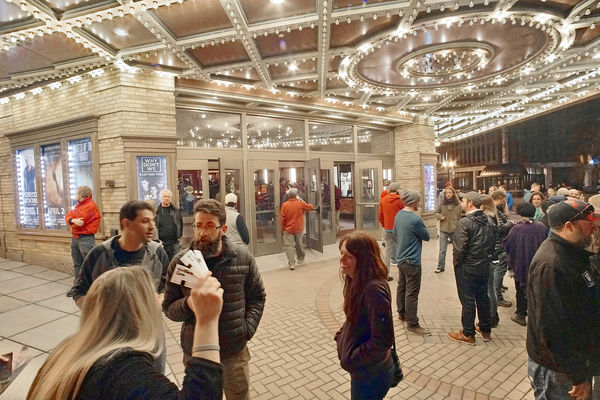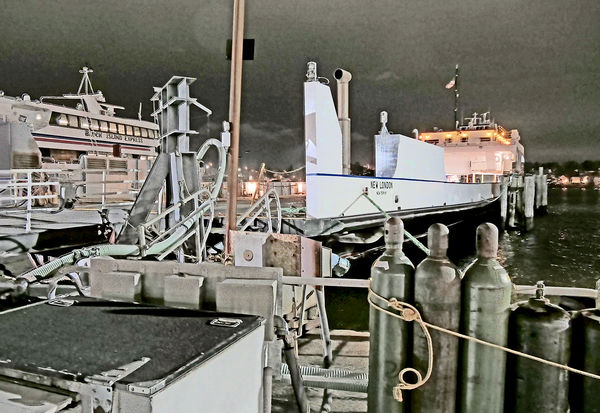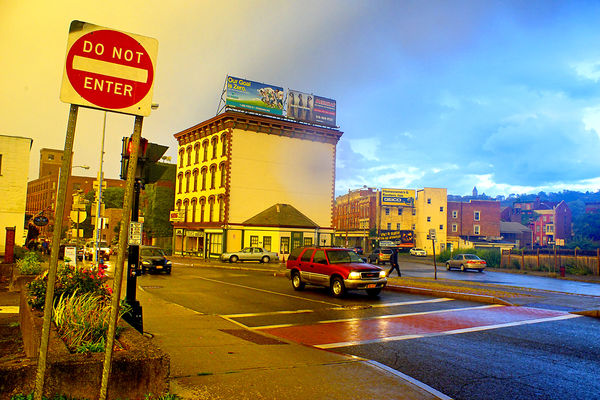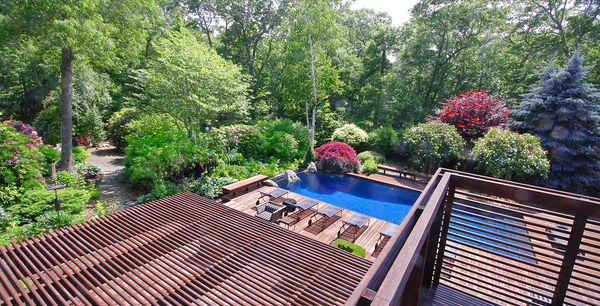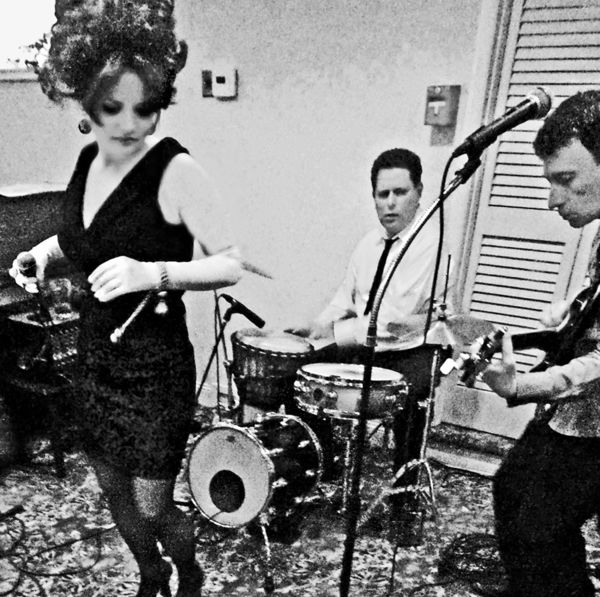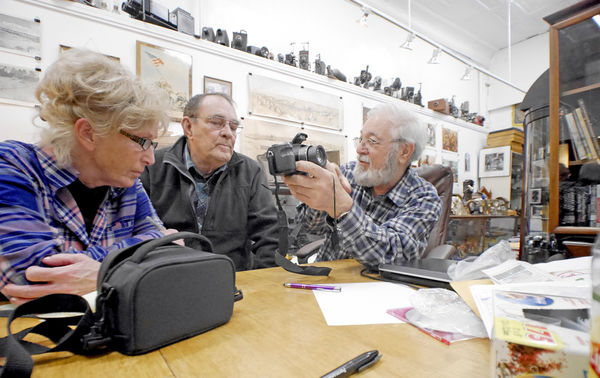Ultra-Wide-Angle Zooms - the benefits, as opposed to the deficits ...
Apr 11, 2019 11:26:57 #
ZenCam wrote:
I have been a very pleased owner of the Sigma 8-16 UWZ. It has proven indispensable for doing some cramped interior images, as well as glorious landscapes. I have 4 Sigma zooms in my camera bag and all of them are fantastic performers. I have the 8-17, 17-70, 18-200, 70-300 APO Macro and they have made me money and always performed with my satisfaction and that of my customers.
That's wonderful, Zen … good to hear you've had some success with those Sigma lenses …
I have the last two (18-200 OS HSM, and the 70-300 APO Macro) but not - the first two …
I have the latter - both in EOS and Nikon F mounts, too. On which bodies do you use yours?
Apr 11, 2019 11:44:48 #
lehighjack
Loc: somewhere in FL
I, too use A mount lenses on my sony cameras. The Sigma 10-20 3.5 is a great Real Estate Lens. Crop sensor it is a 15-30 equivalent and if you match up your horizontal and vertical lines, most distortion is reduced. The lens is not over large and manually focuses well. Auto focus is very, very good. Stopped down to f/5.6 the detail (on a tripod) of the pictures is outstanding. LR can correct aberrations automatically of this lens and most improvements are slight if one properly lines up the lens. It is inexpensive and available. Have fun.
Apr 11, 2019 12:03:33 #
lehighjack wrote:
I, too use A mount lenses on my sony cameras. The ... (show quote)
Yes, I know, Jack - I already have the Sigma 10-20 in EOS Mount. It's a superb lens. But, I was looking to get UWA-Zs for my Sony SLTs, and for my Nikons. I know it would probably make the most sense to buy it again, for those mounts, but I was hoping someone here could steer me to something better for those mounts … with an eye to the Sigma 8-16. I'd be most interested to learn if anyone here has had some success with the Sony a-mount cameras, using that particular lens.

Apr 11, 2019 14:21:13 #
amfoto1
Loc: San Jose, Calif. USA
Chris T wrote:
Sigma takes the prize, currently, with their 8-16 UWA-Z. Others in this category, include the Tokina 11-16, and 11-20, the Tamron 10-24 models, and the other Sigmas, plus all the proprietary ones. Which of these do you think - overall - does the best job on extreme Wide Angle shots? What are the deficits, using them?
Years ago I bought and used the first version of the Tokina 12-24mm f/4 (now superseded by the 12-28mm f/4). At "only" 12mm wide, it has less distortion than some of the others. Also, f/4 is plenty fast for the vast majority of uses for this type of lens.... short focal lengths allow hand holding at much slower shutter speeds and, far more often than not, d end up being stopped down. I saw no reason to spend more for the larger, heavier f/2.8 lenses. Tokina was and still is the only manufacturer offering an f/2.8 lens.... the current 11-20mm f/2.8 is much better, but the 11-16mm f/2.8 they originally offered also has that very narrow range of focal lengths and is very susceptible to flare.
Another reason was price. I got bought the 12-24mm on sale for $400. At the time, the variable aperture Canon 10-22mm zoom (f/3.5-4.5) was close to $700 new. Since then, I've picked up a a very nice used copy of that Canon lens for around $425 (optional lens hood included... tho it's the size of a small Frisbee
 ). In my opinion, it's one of the best ultrawides made by anyone.
). In my opinion, it's one of the best ultrawides made by anyone. I'm glad I'm not a Nikon shooter... until they recently copied Canon's affordable 10-18mm with a Nikkor 10-20mm for around $300, the only Nikkor ultrawides were (and still are) horribly expensive: 10-24mm $900 and 12-24mm $1100! I wonder how many of those they sell, considering they are by far the most expensive of the UWAs for DX cameras.
Nikon shooters also have to be careful with the earlier Tokina ultrawides if they're using any of the D3000 or D5000-series cameras that lack the in-camera autofocus drive mechanism. In the Nikon mount, the original versions of those lenses don't have an in-lens focus motor, so will be manual-focus-only on those cameras (the same is still true of the Tokina 100mm macro lens). The "II" version of the Tokina 11-16mm and 12-24mm in Nikon mount have an in-lens motor, as do the newer 11-20mm and 12-28mm that have superseded them.
In the Canon mount there is no perceptible difference between the original and II versions of the 11-16 and 12-24. They claimed "improved coatings", but I couldn't see any diff and never bothered to upgrade. Incidentally, THK or "Tokina Hoya Kenko" corporation owned Pentax at the time. They didn't offer the Tokina lenses in Pentax mount... but made Pentax-labelled versions of them that appeared identical, except they cost around 50% more!
I widely compared all the available ultrawides when I bought that Tokina 12-24mm years ago.
At the time, Sigma was offering two different 10-20mm. A more affordable 10-20mm f/4.5-5.6 was pretty good and well made, but IMO not quite as good as the Tokina I bought. I also preferred a non-variable aperture (easier to work with manual flash and studio lighting). Sigma also had their 10-20mm f/3.5 (non-variable aperture), but it's big, heavy and was one of the most expensive UWAs at that time. Sigma still offers this lens and have significantly reduced it's price. It's actually now one of the most affordable. The Sigma 8-16mm... the widest of the ultrawides (short of a fisheye lens)... hadn't been introduced yet. After it came out I looked at it briefly and found it interesting, but just too strong wide angle distortion for my purposes, plus it has a high price.
Way back when I bought the Tokina 12-24mm, Tamron had recently discontinued their 11-18mm (one of the first UWA from anyone, though not very good) and had replaced it with the first version of their 10-24mm. That lens was "okay", but not as good as the Sigmas or the Tokina. Today there's a new version of the Tamron 10-24mm with faster focus drive and image stabilization added. I haven't used it so can't say how else it might have been improved from experience, but supposedly it's good.
Testing all that was available then for APS-C Canon, the best of them was clearly the Canon 10-22mm. But, as mentioned above, it was just too pricey for me at the time. So I got the Tokina 12-24mm and used it for several years. It's a nice lens, though it tends to have a bit more chromatic aberration than the Canon 10-22mm. I haven't compared the newer Tokina 12-28mm f/4, but that is reportedly a very nice lens and is available at a very attractive price (under $400 now). The design, build quality and overall "feel" of the Tokina 12-24 (and now their 12-28) remind me of the Canon EF 17-35mm f/2.8L USM that I had sold and was replacing (a nice lens when I shot film, but not wide enough on APS-C cameras).
There also are now the somewhat plasticky, but much more affordable OEM lenses. In 2014 Canon introduced their EF-S 10-18mm IS STM, which now sells for well under $300. In addition to being the most affordable lens of this type, it's also the smallest and lightest UWA and has surprisingly good image quality considering the price. Though perhaps not as essential a feature on an UWA zoom, it also was the first to have image stabilization. It also uses a much more compact lens hood than the EF-S 10-22mm lens. Two or three years later Nikon responded with a more affordable, image stabilized UWA of their own: the Nikkor AF-P 10-20mm VR, which sells for just over $300 (note: AF-P lenses are only fully compatible with some of the more recent camera models). Seems like a nice lens too, tho I don't use modern Nikon gear, so haven't had any opportunity to try it personally.
Sigma also makes a 12-24mm (two older versions, plus now an "Art" version). This is actually a full frame capable lens and rather expensive. The first version is the only one I've had any experience with and it had fairly pronounced distortions. This was correctable in post-processing/ However, because it was complex distortion, wasn't easy until some folks wrote profiles that could be used in some programs (Photoshop, LR, maybe others).
Among the other full frame lenses, the Nikkor 14-24mm f/2.8 and the Canon 11-24mm f/4 lenses are pretty amazing... if a bit pricey. The Canon TS-E 17mm f/4 "Tilt Shift", another expensive option, is possibly the best corrected of them all.
More common full frame UWAs such as the 16-35s and 17-35s haven't impressed me all that much in the past. The old Canon EF 17-35mm f/2.8L USM I used with my film cameras was one of the best of its day, but had a lot of chromatic aberrations. The EF 17-40mm f/4 also never impressed me with it's image quality. I certainly haven't used and compared them all, but it's fairly obvious that Canon finally got it right with their EF 16-35mm f/2.8 "III"... although it ain't cheap and has also grown in size and weight. The EF 16-35mm f/4 IS USM they intro'd a couple years ago is a brilliant alternative... almost as good IQ at half the price, smaller and lighter... plus it has IS!
So many lenses, so little time!

Apr 11, 2019 14:36:01 #
amfoto1 wrote:
Years ago I bought and used the first version of t... (show quote)
Thanks for that "almost" complete rundown of all currently-available UWA-Zs, Alan … as always - nice and elaborate. Wonder why you weren't impressed by that EF 17-40L, Alan ... did you actually USE one?

Apr 11, 2019 16:50:46 #
Gene51 wrote:
Ultrawides are pretty specialized lenses and only a relatively small percentage of photographers are actually successful using them. Lots of anamorphosis, complex distortion, uneven brightness across the frame, etc and a completely unrealistic perspective. I prefer to use a longer lens and simply stitch images for wider views. Most of the deficits come from shooters not fully understanding how to make good images with them.
Ultra wide isn't good for images that need wide angle of view. I think it's good for images that you can't really see with your eyes due the the ultra wide angle. It can be interesting for a while but it's kind of hard to be creative with it all the times.
Apr 11, 2019 17:46:58 #
BebuLamar wrote:
Ultra wide isn't good for images that need wide angle of view. I think it's good for images that you can't really see with your eyes due the the ultra wide angle. It can be interesting for a while but it's kind of hard to be creative with it all the times.
There's a recent set in the Gallery, Bebu … all taken of the Australian shore-line, with the Sigma 8-16.
They're pretty effective, and showing no distortion, whatsoever … take a look …

Apr 11, 2019 19:22:19 #
`
Different versions go on sale at different
times. I always buy the one thaz on sale
at the time that I'm ready to buy one. If
it's not as good as some other lens I just
don't tell anyone about that situation.
Different versions go on sale at different
times. I always buy the one thaz on sale
at the time that I'm ready to buy one. If
it's not as good as some other lens I just
don't tell anyone about that situation.
Apr 11, 2019 19:34:00 #
User ID wrote:
`
Different versions go on sale at different
times. I always buy the one thaz on sale
at the time that I'm ready to buy one. If
it's not as good as some other lens I just
don't tell anyone about that situation.
Different versions go on sale at different
times. I always buy the one thaz on sale
at the time that I'm ready to buy one. If
it's not as good as some other lens I just
don't tell anyone about that situation.
Neat pic, there, User … where'd you shoot that?
So - Mum's the word, eh, User? … If it's not as good as another - you keep it a secret, then - do ya?

Apr 11, 2019 21:18:28 #
BebuLamar wrote:
Ultra wide isn't good for images that need wide angle of view. I think it's good for images that you can't really see with your eyes due the the ultra wide angle. It can be interesting for a while but it's kind of hard to be creative with it all the times.
Totally agree - specialized lenses for specific situations, often selected by less experienced shooters who what ultrawide so they can "get it all in" - even though the elements in the distance might as well be in the next state. And as UserID has clearly shown - they do provide a "unique" perspective on things - not my cup of tea at all.
Apr 11, 2019 21:27:38 #
Chris T wrote:
Gene - there's a set posted here, yesterday, at the Gallery, taken of the shoreline, in Australia, w/ the 8-16.
They are really quite impressive - which got me to thinking, again - about picking up a copy …
The shots are quite even … the best set I've ever seen, taken with that lens … take a look!!!!
They are really quite impressive - which got me to thinking, again - about picking up a copy …
The shots are quite even … the best set I've ever seen, taken with that lens … take a look!!!!
link?
Apr 11, 2019 21:37:00 #
Gene51 wrote:
link?
I'll have to look for it, Gene … it was a couple of days, ago, now … will see what I can do …

Hereyago. Gene … it was on the 9th - entitled - Ultra wide lens at the seaside …
https://www.uglyhedgehog.com/t-586662-1.html
Enjoy!!!!
Apr 12, 2019 00:32:34 #
PHRubin wrote:
https://www.digitalcameraworld.com/buying-guides/best-wide-angle-lenses-for-canon
Thanks for the reference. I have the Canon 10-18 and am happy with it. Back in 76 I had a 35mm and when I went to Europe I quickly found out it wasn't wide enough!
Apr 12, 2019 20:37:16 #
`
All very fair remarks, Gene, but then sometimes .....
sometimes you just reeeeeeally wanna "get it all in".
Went for my usual breakfast, and the band for the day
was a trio .... and then friends started showing up .....
including a second double bass ! Sooooo, I just really
hadda "get it all in." :-)
Gene51 wrote:
Totally agree - specialized lenses for specific situations,
often selected by less experienced shooters who what
ultrawide so they can "get it all in" - even though the
elements in the distance might as well be in the next
state. And as UserID has clearly shown - they do provide
a "unique" perspective on things - not my cup of tea at all.
Totally agree - specialized lenses for specific situations,
often selected by less experienced shooters who what
ultrawide so they can "get it all in" - even though the
elements in the distance might as well be in the next
state. And as UserID has clearly shown - they do provide
a "unique" perspective on things - not my cup of tea at all.
All very fair remarks, Gene, but then sometimes .....
sometimes you just reeeeeeally wanna "get it all in".
Went for my usual breakfast, and the band for the day
was a trio .... and then friends started showing up .....
including a second double bass ! Sooooo, I just really
hadda "get it all in." :-)
Apr 13, 2019 10:47:46 #
User ID wrote:
`
Different versions go on sale at different
times. I always buy the one thaz on sale
at the time that I'm ready to buy one. If
it's not as good as some other lens I just
don't tell anyone about that situation.
Different versions go on sale at different
times. I always buy the one thaz on sale
at the time that I'm ready to buy one. If
it's not as good as some other lens I just
don't tell anyone about that situation.
User - this is quite a collection of shots. Not sure I get why you posted them all together, though …
Don't think they're all taken with UWA-Zs - are they?

If you want to reply, then register here. Registration is free and your account is created instantly, so you can post right away.


